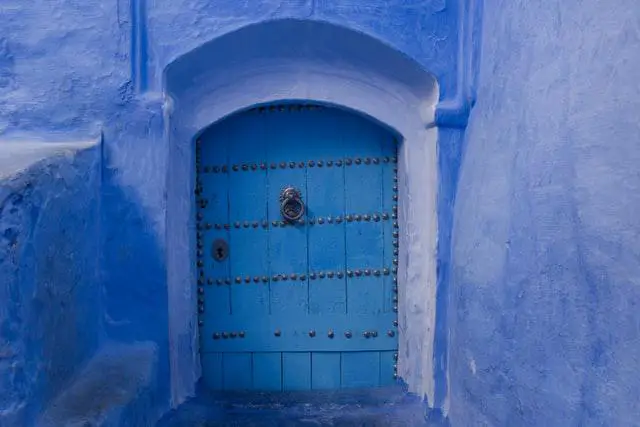Colors played an integral role in classifying the societal structure of the Byzantine Empire. No color would play a more crucial role in the history of this ancient civilization than green and blue. During the 6th century, the Byzantine society was divided by their support for two color-themed political factions – Greens and Blues. It was a divide between the blue symbolism of aristocracy and religious orthodoxy and the green symbolism of commonality and religious heresy.
Origins of Byzantine Blue
The Byzantine Empire inherited these green and blue symbolisms from their Roman counterparts. The Romans had for long entertained themselves with chariot racing, traditionally competed between four color-themed teams of red, white, green and blue. Each of which garnered a cult following from the entertainment-hungry public. When the Roman Empire crumbled into numerous feudal kingdoms, the eastern half of the once mighty empire formed the Byzantine Empire. By the 6th century, the four color-themed chariot racing teams had absorbed each other, and only the Blues and the Greens remained. Both the teams were wildly popular in Byzantium and their fanatical supporters were often responsible for inciting violent riots. With time, these two colors slowly evolved into pseudo-political parties having massive influence over the population.
[Image source – Unsplash]
Emperor and his colors
Since the Blues symbolized nobility, the Emperor and other noble families were known to favor this political faction. The Emperor himself, associated with a color which is a cousin of blue – purple. Purple had for long represented divinity and royalty. The rare and expensive nature of the purple dye made it perfect for distinguishing the ruler from the ruled.
Color coding and color hierarchy was such an important part of societal control that Emperor Theodosius I forbade manufacture and use of certain ‘imperial’ shades of purple. In the hierarchy of color dyes, ‘imperial’ purple stood at the summit, followed other ‘imitation’ shades of purple, after which came red and blue. Yellow and green were at the bottom. The words used to describe yellow and green were closely related to fear, weakness and sickness. In the later years of the Byzantine Empire, a ruler of a Greek Byzantine state banned imports of Chinese, Egyptian and Syrian garments to maintain the exclusivity of imperial colors.
Blue versus Green
The friction between the blue symbolism of aristocracy and the green symbolism of commonalty would come to head during the reign of one of Byzantium’s greatest yet most controversial emperor, Justinian.
In the 5th and 6th century, the two color-coded political factions, Greens and Blues, gained such significance that they would go on to threaten to tear down an entire empire. At the crux of this rift was religion, a central figure of a Byzantine life. Blues and Greens were divided in their depiction of Jesus Christ. Greens were advocates of an influential heresy which held the opinion that Christ had only one nature was not simultaneously divine and human. The religious divide and the socioeconomic gulf between the two political factions, combined with a regime of heavy taxation in 532 AD nearly ended the Byzantine Empire.
It was at a time when Emperor Justinian had been campaigning a great deal and recovering areas from North Africa, Italy and other parts of Europe. But these military campaigns came at an enormous cost. Costs that were eventually reverted to the public in forms of numerous new taxes. By 532 AD, even the empire’s wealthiest were taxed for the first time. There was discontentment throughout Constantinople and violence broke out between the Blues and the Greens.
Nika Riots
The Blues were astonished when the Emperor withdrew his allegiance to them, and order the execution of ringleaders from both the factions. On the next chariot racing event, the Blues and the Greens assembled in Constantinople’s Colosseum-like arena, Hippodrome, chanted angrily at the Emperor. The races were abandoned. Soon, a mob engulfed the city and began to burn it down.
On the fifth day of rioting, the two political factions now united under a common cause. Together they sought a replacement for the Emperor and placed a nephew of a former ruler on the Imperial throne in the Hippodrome.
Justinian, initially panicked and was about to flee the city when he was persuaded by his Empresses, Theodora, to stay and fight. The Blues and The Greens assembled in the Hippodrome were locked inside and a legion of troops most loyal to the throne were sent to kill them. Historians suggest that around 10 percent of the city population were killed at the Hippodrome massacre. This riot, historically known as the ‘Nika Riot’, would mark the end of a remarkable era. It was an end of a time when two color-themed factions enjoyed a considerable social, economic and political influence over one of the greatest civilizations in history.

[Image source – Unsplash]
Societal color codes
Ancient texts like the Book Of the Perfect indicate the symbolic meaning and importance attached to the brightness and saturation of hue in Byzantine color perception. Dying of cloth was an elaborate process detailed to the strength of dyes and the number of cloth dips. Those charged with making imperial dresses were under heavy scrutiny of making no mistakes. There is a famous story of an imperial weaver, who had spoilt an imperial clothing during the process of purple dying. The unlucky man had to flee Cairo to raise a ransom for his children held elsewhere. This story reveals an extraordinary obsession among the people of Byzantine, especially the nobility, to be defined and distinguished with color.
With this color coding embedded in Byzantine mentality, blue became one of the most prominent identifier and distinguisher. Many members of the Byzantine population associated with blue because of their noble or upper-class lineage. They also affiliated in its symbolism of a contrary political ideology to its green counterpart. Byzantium’s central geographical position had made it a melting pot of society with its capital Constantinople (modern-day Istanbul) which was as an incredibly diverse ancient city. However, their caste-ridden society was broadly divided in to two group of citizens: the honestiores or the privileged and the humiliores or the humble. It was by birth and not by choice that an individual learnt to associate himself with either green or blue.
Blue symbolism in Christianity
Faith and religion were a crucial part of Byzantine society. The empire was influential in shaping Christian Orthodoxy and modern-day Eastern Orthodox Church remains the second largest Christian Church in the world. Art and literature were persuasive in Christianity’s rising popularity during the Byzantine Renaissance from 867 AD to 1056 AD. Literary works depicting Saints as heroes doing God’s work and banishing demons were published.
Art in Byzantium was primarily related to religion. Churches communicated with the poor and the illiterate through vivid paintings depicting sins, morals and divinity of religion. Byzantine painters used colors as a medium to express brilliance and evoke devotion.
The color, blue, was extensively used in religious art. Blue symbolized purity and was considered the color of The Virgin Mary. Blue was extensively used in frescoes and mosaics. It is evident that colors played a vital role in creating meaning and relaying power and sanctity messages.

[Image source – Unsplash]
Blue in Byzantium
It is clear that the understanding and use of blue in Byzantium had a greater philosophical importance than anywhere else at the time. Their traditional view of color coding of society is crucial to understand the people of that epoch. For many, blue was an identity. It was a representative of their political bias and their social status. For many, it was blue that chose them. Their fortunate birth in an upper-class nobility set their destiny with blue.
Blue found its place in religion, too. As Christianity promoted visual depictions and art began to thrive, blue found its place in one of the holiest places – Mother Mary. As a symbol of purity, blue was extensively used in Churches on glass-tinted mosaics and vivid frescoes.
What ultimately defines blue in Byzantine history is its symbolism of upper-class and religiously orthodox political factions. The Nika Riots was a major event in Byzantine history. Two colors had amazingly combined to challenge the highest authority of the land. The Blues and The Greens almost overthrew Emperor Justinian. The centuries-long battle between the two colors would end remarkably with both sides uniting for a common goal. Alas, there would be no winners at the end of this lengthy yet colorful conflict. Only one color was seen in Constantinople at the end of the Nika Riots and it was neither green nor blue. It was red. That of the blood spilled of thousands who were massacred at the Hippodrome in 532 AD.
The blue symbolism of haves versus the green symbolism of have-nots is ever-present even today. Today’s battle is not as raw and evident as it was in Byzantium. The 21st century struggle between the rich and the poor is more subtle than that.




